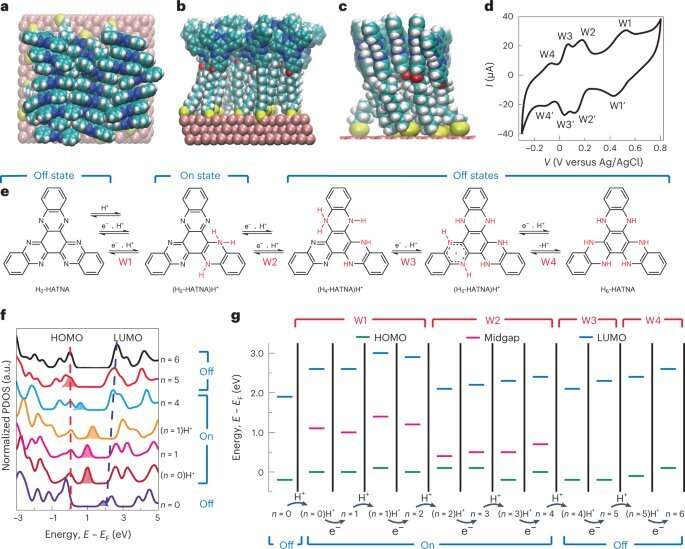Discovery reveals 'brain-like computing' at molecular level is possible

A discovery at University of Limerick in Ireland has revealed for the first time that unconventional brain-like computing at the tiniest scale of atoms and molecules is possible.
Researchers at University of Limerick's Bernal Institute worked with an international team of scientists to create a new type of organic material that learns from its past behavior.
The discovery of the "dynamic molecular switch" that emulates synaptic behavior is revealed in a new study in the journal Nature Materials.
The study was led by Damien Thompson, Professor of Molecular Modeling in UL's Department of Physics and Director of SSPC, the UL-hosted Science Foundation Ireland Research Center for Pharmaceuticals, together with Christian Nijhuis at the Center for Molecules and Brain-Inspired Nano Systems in University of Twente and Enrique del Barco from University of Central Florida.
Working during lockdowns, the team developed a two-nanometer thick layer of molecules, which is 50,000 times thinner than a strand of hair and remembers its history as electrons pass through it.
Professor Thompson explained that the "switching probability and the values of the on/off states continually change in the molecular material, which provides a disruptive new alternative to conventional silicon-based digital switches that can only ever be either on or off."
The newly discovered dynamic organic switch displays all the mathematical logic functions necessary for deep learning, successfully emulating Pavlovian "call and response" synaptic brain-like behavior.
The researchers demonstrated the new materials properties using extensive experimental characterization and electrical measurements supported by multi-scale modeling spanning from predictive modeling of the molecular structures at the quantum level to analytical mathematical modeling of the electrical data.
To emulate the dynamical behavior of synapses at the molecular level, the researchers combined fast electron transfer (akin to action potentials and fast depolarization processes in biology) with slow proton coupling limited by diffusion (akin to the role of biological calcium ions or neurotransmitters).
Since the electron transfer and proton coupling steps inside the material occur at very different time scales, the transformation can emulate the plastic behavior of synapse neuronal junctions, Pavlovian learning, and all logic gates for digital circuits, simply by changing the applied voltage and the duration of voltage pulses during the synthesis, they explained.
"This was a great lockdown project, with Chris, Enrique and I pushing each other through zoom meetings and gargantuan email threads to bring our teams combined skills in materials modeling, synthesis and characterization to the point where we could demonstrate these new brain-like computing properties," explained Professor Thompson.
"The community has long known that silicon technology works completely differently to how our brains work and so we used new types of electronic materials based on soft molecules to emulate brain-like computing networks."
The researchers explained that the method can in the future be applied to dynamic molecular systems driven by other stimuli such as light and coupled to different types of dynamic covalent bond formation.
This breakthrough opens up a whole new range of adaptive and reconfigurable systems, creating new opportunities in sustainable and green chemistry, from more efficient flow chemistry production of drug products and other value-added chemicals to development of new organic materials for high density computing and memory storage in big data centers.
"This is just the start. We are already busy expanding this next generation of intelligent molecular materials, which is enabling development of sustainable alternative technologies to tackle grand challenges in energy, environment, and health," explained Professor Thompson.
More information: Enrique del Barco, Dynamic molecular switches with hysteretic negative differential conductance emulating synaptic behaviour, Nature Materials (2022). DOI: 10.1038/s41563-022-01402-2
Journal information: Nature Materials
Provided by University of Limerick





















